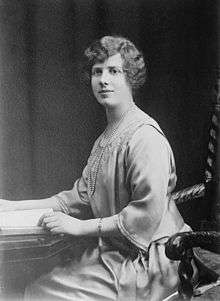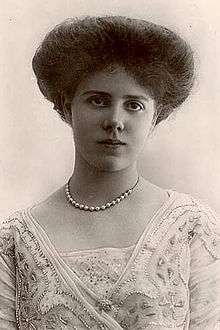Princess Maud, Countess of Southesk
| Princess Maud | |||||
|---|---|---|---|---|---|
| Countess of Southesk | |||||
 | |||||
| Born |
3 April 1893 East Sheen Lodge, Richmond-upon-Thames | ||||
| Died |
14 December 1945 (aged 52) London | ||||
| Spouse | Charles Carnegie, 11th Earl of Southesk | ||||
| Issue | James Carnegie, 3rd Duke of Fife | ||||
| |||||
| Father | Alexander Duff, 1st Duke of Fife | ||||
| Mother | Louise, Princess Royal | ||||
Princess Maud Alexandra Victoria Georgina Bertha (3 April 1893 – 14 December 1945), later Countess of Southesk, was a granddaughter of the British king Edward VII. Maud and her elder sister, Alexandra, had the distinction of being the only female-line descendants of a British sovereign officially granted both the title of Princess and the style of Highness.[1][2] Despite the fact that they were not daughters of a royal duke, they were sometimes unofficially referred to with the territorial designation of Fife but in official documents, until their marriages, they were always styled Her Highness Princess Maud or Alexandra, without the territorial designation "of Fife".[3]
Although Princess Maud did not otherwise carry out royal engagements, because of her position in the Commonwealth's order of succession she served as a Counsellor of State between 1942 and 1945.
Early life
Maud was born at East Sheen Lodge, Richmond-upon-Thames, Surrey on 3 April 1893. Her father was Alexander Duff, 1st Duke of Fife (1840–1912).[3] He was raised from Earl to Duke of Fife following marriage to Maud's mother, Princess Louise of Wales, the eldest daughter of the future King Edward VII.[3]
Maud and her sister were unique in sharing descent from both William IV (through his mistress, Dorothy Jordan), and William IV's niece, Queen Victoria, who succeeded him because he left no legitimate issue.[3]
Princess

In 1900, Queen Victoria granted Maud's father a second dukedom of Fife in the peerage of the United Kingdom with a special remainder providing for the succession of the duke's daughters and their male-line descendants to the title, in default of a male heir. Maud became second in line to the dukedom, after her elder sister Alexandra, and her descendants would eventually succeed to the peerage.
As a female line great-granddaughter of a British monarch (Queen Victoria), Maud was not entitled to the title of a Princess of the United Kingdom of Great Britain and Ireland nor to the attribute Royal Highness. Instead she was styled Lady Maud Duff, as the daughter of a duke.[3] She was sixth in the line of succession to the British throne at the time of her birth.
On 5 November 1905, King Edward VII gave Maud's mother the title of Princess Royal. He further ordered Garter King of Arms to gazette Maud and her sister with the style and attribute of Highness and the style of Princess prefixed to their respective Christian names, with precedence immediately after all members of the British Royal Family bearing the style of Royal Highness.[3]
She took part in the carriage procession for members of the Royal Family when she attended the funeral of Edward VII in 1911 (she was styled in the London Gazette as "Her Highness Princess Maud" and her sister "Her Highness Princess Alexandra", both without the territorial designation "of Fife").[4] She attended the coronation of her uncle, George V, on 22 June 1911 with the Royal Family, styled as "Her Highness Princess Maud" (without territorial designation)[5]
Maud's uncle, King George V, in letters patent dated 20 November 1917, restructured the styles and titles of the royal family by restricting the titles of Prince or Princess and the style of Royal Highness to the children of the sovereign, the children of the sovereign's sons, and the eldest living son of the eldest son of the Prince of Wales. The Letters Patent also stated that "the titles of Royal Highness, Highness or Serene Highness, and the titular dignity of Prince and Princess shall cease except those titles already granted and remaining unrevoked". This had no direct effect on Maud and her sister, whose rank and style derived from the specific promotions granted to them by their grandfather, Edward VII. However, Maud complied with George V's wish that she stop using her title and style of Princess and Highness. He did not, however, retract the royal warrant conferring the princely title and attribute upon her.
She rode in the carriage procession with members of the Royal Family at the funeral of George V in 1936; on this occasion she was styled in the London Gazette as "Lady Maud Carnegie".[6] She also attended the coronation of her first cousin, King George VI in May 1937, taking part in the procession of Members of the Royal Family, but not in the procession for Princes and Princesses of the Blood Royal (unlike her sister Princess Arthur of Connaught, who was married to a Prince of the Blood Royal), and was officially styled as Lady Maud Carnegie.[7]
Marriage
On 13 November 1923, Maud married Charles, Lord Carnegie (23 September 1893 – 16 February 1992) at the Royal Military Chapel, Wellington Barracks, London.[3] Lord Carnegie was the eldest son of Charles Noel Carnegie, 10th Earl of Southesk and inherited the title of Earl of Southesk on his father's death on 10 November 1941.
Maud and her husband operated a model farm from Elsick House, in Kincardineshire, Scotland. They had one child, James (23 September 1929- 22 June 2015).[3]
Later life
Princess Maud consistently appeared at the Court of St. James's among the Royal Family, although she did not undertake official or public duties. During George VI's absence in Africa in 1943, Maud served as a Counsellor of State. At the time of her death in 1945, she was thirteenth in line to the British throne and heiress presumptive to the dukedom of Fife, since her sister's only son Alastair Windsor, 2nd Duke of Connaught and Strathearn, had died in 1943. Maud's only son James, Lord Carnegie, succeeded his aunt as 3rd Duke of Fife in 1959.[3] He succeeded to his father's titles in 1992.
Maud died in a London nursing home in December 1945 after a bout of acute bronchitis.
| Wikimedia Commons has media related to Princess Maud of Fife. |
Titles and styles
- 3 April 1893 – 5 November 1905: Lady Maud Duff*
- 5 November 1905 – 12 November 1923: Her Highness Princess Maud
- 12 November 1923 – 10 November 1941: Lady Maud Carnegie
- 10 November 1941 – 14 December 1945: The Countess of Southesk
- Princess Maud chose to discontinue use of the style of Princess and Highness upon marriage.
Ancestry
References and notes
- ↑ The London Gazette: (Supplement) no. 27852. p. 7495. 9 November 1905. Retrieved 13 September 2015.
- ↑ The distinction lies in being granted the styles of both Princess and Highness. Other female-line descendants of a British sovereign, such as the children of Prince and Princess Christian of Schleswig-Holstein and of Prince and Princess Henry of Battenberg, had been granted the style of Highness, but not that of Prince or Princess, presumably because they derived a princely style from their fathers, which was not the case of Princess Maud and Princess Alexandra. Their cousin Princess Victoria Eugénie of Battenberg was born "Highness" by virtue of an 1885 warrant of Queen Victoria and was created "Royal Highness" by Edward VII immediately prior to her 1906 marriage to the King of Spain: The London Gazette: (Supplement) no. 27901. p. 2421. 4 April 1906. Retrieved 13 September 2015.
- 1 2 3 4 5 6 7 8 9 Montgomery-Massingberd, Hugh (editor). Burke's Guide to the Royal Family, Burke's Peerage, London, 1973, p. 306. ISBN 0-220-66222-3
- ↑ The London Gazette: (Supplement) no. 28401. p. 5471. 26 July 1910. Retrieved 13 September 2015.
- ↑ The London Gazette: (Supplement) no. 28535. p. 7077. 27 September 1911. Retrieved 13 September 2015.
- ↑ The London Gazette: (Supplement) no. 34279. p. 2763. 29 April 1936. Retrieved 13 September 2015.
- ↑ The London Gazette: (Supplement) no. 34453. p. 7044. 10 November 1937. Retrieved 13 September 2015.